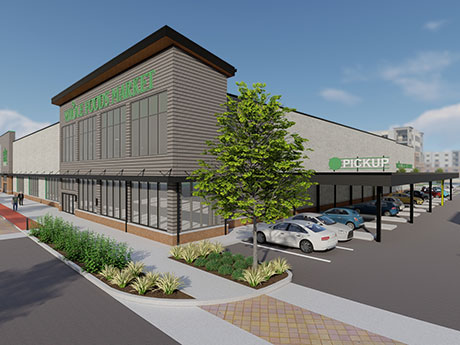The future of retail is bright for those willing to innovate, says Kathleen Brill, executive vice president and director of leasing and strategic partnerships for East Peoria, Illinois-based Cullinan Properties.
“It’s no longer about square footage — it’s about activation,” emphasizes Brill. “Mixed-use, walkability and experience will continue to shape leasing trends.”
Grant Mechlin, executive director of retail and multifamily brokerage services for St. Louis-based Sansone Group, says the narrative of retail leasing has shifted from survival to strategy.
“Retailers are being more selective about where and how they grow, but there is no slowdown in activity,” he says. “Physical stores remain critical to brand identity, customer acquisition and fulfillment. Looking ahead, we expect to see more hybrid uses, especially where retail blends with wellness, services and entertainment.”
Today’s retailers are activating their storefronts and rightsizing their footprints at a time when the cost of construction is at a record high, and many national chains have announced store closures or bankruptcies.
The supply pipeline, already extremely thin by historical standards, will be further constrained by rising construction costs, helping limit fluctuations in vacancy rates, states Cushman & Wakefield in its first-quarter retail report. The brokerage firm reports a national vacancy rate of 5.5 percent, up 20 basis points from the historic low observed a year ago.
The amount of retail space under construction in the first quarter totaled 10.6 million square feet, down from 11.6 million square feet in first-quarter 2024. Cushman & Wakefield’s scope of data includes neighborhood, power and strip centers, but it excludes malls, outlets and freestanding retail product.
Retail store closures across the country may free up almost 140 million square feet of much-needed retail space, according to JLL in its fourth-quarter retail report (the latest data available from the brokerage firm). Junior anchors Party City, Walgreens, Rite Aid and Badcock Home Furniture have closed or plan to shutter a total of 2,693 locations nationwide.
Big box stores, including Big Lots, 99 Cents Only, American Freight and Dirt Cheap, have or will close 1,528 locations. JLL includes malls, power centers, shopping centers and other general retail categories in its coverage.
Terry McCollom, president of Pana, Illinois-based McCollom Realty Ltd., says he has never observed the cost of construction as high as it is today in his more than 50 years in the business. “It’s out of control,” he says. “Future development will be very slow, except for major corporations like McDonald’s or Starbucks that can build their own properties.”
In March, outsized one-month increases occurred in the producer price indexes for steel mill products (7.1 percent), aluminum mill shapes (5.1 percent) and lumber and plywood (2.7 percent), according to the Associated General Contractors of America (AGC).
President Trump imposed a 25 percent tariff on steel and aluminum imports starting March 12, affecting the cost of many domestically produced construction materials, equipment, heavy trucks and trailers, according to the AGC.
On April 2, the president imposed a “reciprocal tariff” policy, including a 10 percent baseline tariff on almost every country. Some of the president’s goals for the tariffs include restoring U.S. manufacturing, helping offset planned tax cuts, paying down the national debt and reducing trade deficits such as the one the U.S. runs with China, according to CNBC.
Who’s expanding?
Despite economic uncertainty and concerns regarding tariffs, retail tenants such as experiential users, fitness concepts, medical tenants and quick-service restaurants are looking to expand.

“We’re seeing significant growth in experiential tenants — everything from family entertainment and competitive socializing concepts to upscale fitness and wellness,” says Brill. “Quick-service and fast-casual restaurants continue to aggressively expand, especially those with strong drive-thru and digital ordering infrastructure.”
According to Mechlin, fast-casual favorites such as Shake Shack, Cava, Chipotle, First Watch and Einstein Bros. Bagel continue to grow. He says Chick-fil-A leads the quick-service category. In the coffee segment, Dutch Bros, 7 Brew, Scooter’s, Starbucks and Dunkin’ are actively opening new locations.
In one example, Mechlin negotiated a lease with Shake Shack in the St. Louis suburb of Sunset Hills. The burger joint will occupy 3,500 square feet of space, representing a portion of a former Fuddruckers location.
On the food-and-beverage front, developer Steiner + Associates is targeting premium dining concepts, according to Spencer Jordan, senior vice president of leasing for the Columbus, Ohio-based firm. These users “can function as both a destination and an anchor for adjacent retail,” she says.
For example, Mastro’s Steakhouse, a high-end seafood and steak restaurant, recently opened a 9,000-square-foot location at Easton Town Center in Columbus. The space features two main dining rooms, one private dining room, two outdoor patio spaces, a double-faced bar, piano lounge and semi-private wine room.
Karsyn Smith, sales associate at Block & Co. Inc. Realtors in Kansas City, says that service-based tenants such as restaurants, gyms and personal care services like hair salons and nail salons, are experiencing notable growth and outpacing goods-based retailers. She says that the pandemic heightened the desire for services that cater to health, well-being and personal care.
Smith has also observed the expansion of value and discount retailers, saying that “consumers prioritize affordability in response to economic uncertainty and rising living costs.”
Block & Co. recently welcomed Sierra, an off-price retailer owned by TJX Cos., at Orchard Corners shopping center in Lenexa, Kansas. A former SteinMart property was renovated and split in two to make way for Sierra and Petco, which is slated to open by the end of the year.
Josh Dinstein, senior vice president of commercial acquisitions for Baltimore-based owner Continental Realty Corp. (CRC), cites experiential users like Activate, an interactive gaming facility, or The Picklr, a pickleball facility. Both tenants have signed leases at Fox River Commons, a 241,000-square-foot shopping center in the Chicago suburb of Naperville. Dinstein also favors bringing medical users to CRC’s retail properties, particularly dentists.
“Dental tenants are the best,” he says. “We would love to bring more to our properties. They have a regular customer and are very sticky, meaning they don’t like to move.”
McCollom echoes this sentiment, saying that adding medical users to retail spaces “is a must.” As of mid-April, McCollom was in negotiations with a medical tenant for a retail vacancy in Orland Park, Illinois, a southwest suburb of Chicago.
What retailers want
What are retailers looking for in the spaces they lease today? In addition to longstanding preferences such as visibility and accessibility, there’s a strong emphasis on co-tenancy and facilities that support omnichannel strategies.
“Co-tenancy is more important than ever,” says Brill. “Retailers are looking to be surrounded by complementary uses — restaurants, entertainment, fitness, residential — that keep people coming back throughout the day.”
Operationally, retailers want spaces that are “flexible and future-ready,” says Jordan. In other words, they seek features that support last-mile fulfillment, curbside pickup, mobile checkout or other technologies like interactive displays.
“Omnichannel is now the baseline,” says Jordan. “Consumers expect retailers to meet them wherever they are, so brick-and-mortar must complement a strong digital strategy.”
Jordan also says that there’s a greater emphasis on storytelling and brand immersion today. “Retailers want environments where they can create a memorable experience, not just transact,” she states. “And increasingly, they’re asking, ‘Does this center reflect who we are?’ That means sustainability, community engagement and aesthetics are all part of the conversation now.”
Dinstein acknowledges that retailers want to be in a favorable location with a landlord that is well capitalized, ensuring a shopping center stays well maintained.
Mechlin says that grocery-anchored shopping centers remain in high demand due to their ability to attract steady foot traffic. His firm and Clous Road Partners recently broke ground on a new retail development in metro Cincinnati that will be anchored by a 40,000-square-foot Whole Foods Market store. Dubbed Village North, the five-building, 91,000-square-foot project is slated to open next year.
Additionally, Mechlin says that endcap and outparcel locations are desirable, especially for tenants that rely on drive-thru convenience as limited new construction has made these spaces more competitive. (An endcap is a storefront space located at either end of a shopping center or strip center. An outparcel refers to a standalone property, typically a smaller lot, located within or adjacent to a larger development.)
A growing number of retailers are opting for smaller footprints in response to inflation and heightened interest rates that have affected both consumer spending and business expenses, says Smith.
“Smaller footprints allow retailers to optimize space, cut down on overhead costs and remain more agile. This trend toward downsizing reflects a broader shift in how brands operate, with an increased focus on efficiency and cost management,” continues Smith.
“Looking ahead, the future of retail leasing is likely to be shaped by continued shifts in consumer behavior, with an increasing focus on value, convenience and experience.”
— Kristin Harlow
This article originally appeared in the May 2025 issue of Heartland Real Estate Business magazine.


